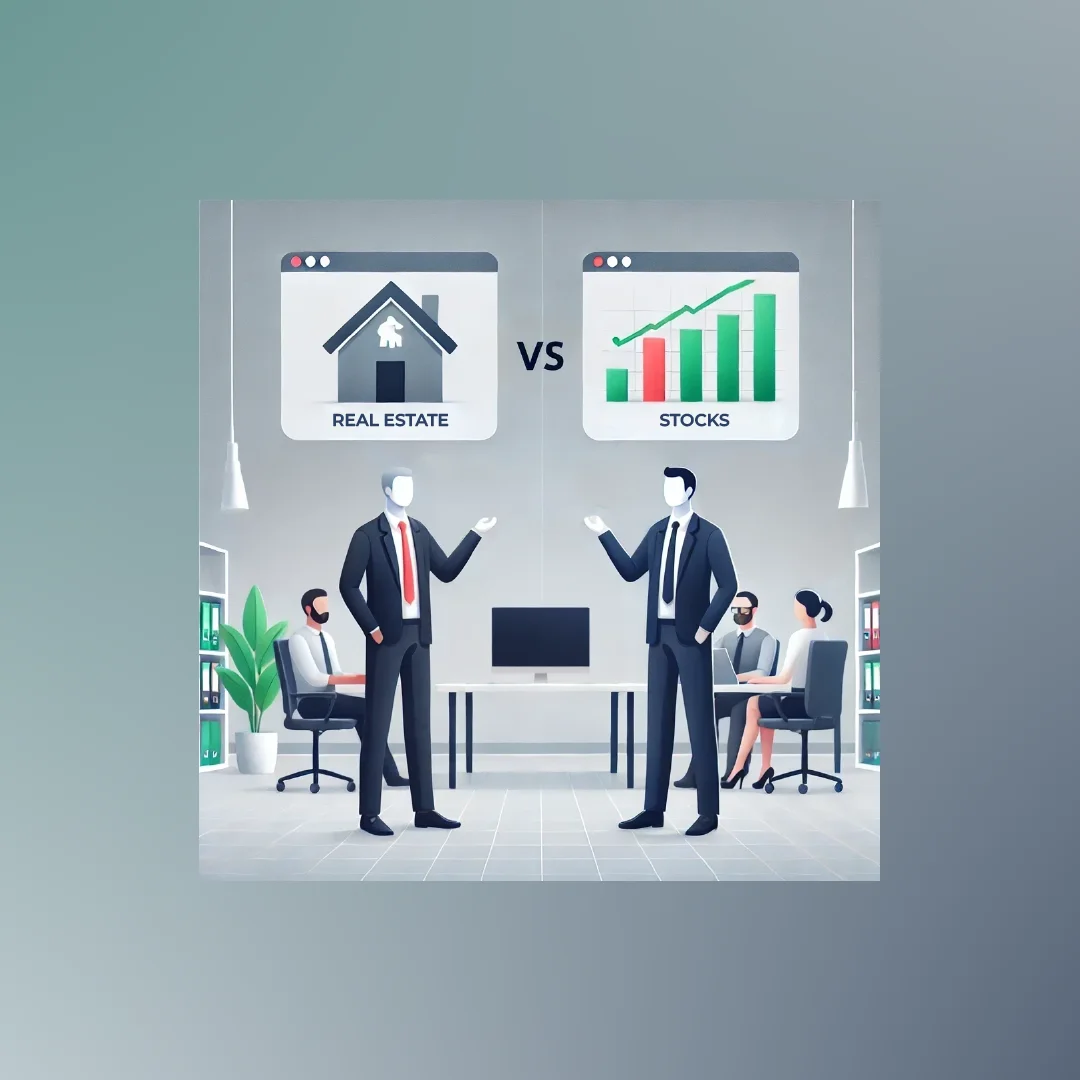
Just like you have to balance fruits, veggies, and proteins to meet your health goals, you have to manage the right mix of different financial assets to get where you want financially.
An investment portfolio does just that, aiming to reduce risk and maximize your returns. But what exactly is an investment portfolio?
Let’s explore the basics of an investment portfolio, discuss different types of investment accounts, and more.
What Exactly is an Investment Portfolio?
a person working on a laptop in a minimalist office, with labels for 'Stocks,' 'Bonds,' and 'Mutual Funds' on the wall, symbolizing investment portfolio management.
An investment portfolio is a collection of financial assets owned by an investor. These assets are carefully selected to work together towards specific financial goals. It's all your investments grouped together.
A good portfolio aims to balance risk with potential returns by diversifying across asset classes, sectors, and geographical regions. They can be stocks, bonds, ETFs, etc. The exact allocation depends on the individual investor's circumstances and objectives.
Why are Investment Portfolios Important?
A good investment portfolio can significantly impact your financial health and future. It offers several key benefits:
1. Spreading Out Risk
An investment portfolio lets you put your money in different types of investments. This diversification is like not putting all your eggs in one basket. If one investment does poorly, others might do well, which can help balance things out. For example, when stocks struggle, bonds might perform well, balancing out your portfolio's performance.
2. Matching Investments to Your Goals
Your portfolio can be set up to fit what you want to achieve. Whether you're saving for retirement, a new home, or your kids' education, you can choose investments that help you reach these goals.
3. Balancing Risk and Return
Portfolios help strike a balance between risk and potential returns. By combining assets with different risk profiles, you can optimize your portfolio to achieve the highest possible return for your personal risk tolerance.
4. Seeing the Big Picture
With a portfolio, you can see all your investments in one place. This makes it easier to understand how you're doing and make smart choices about rebalancing or adjusting your investment strategy.
5. Changing with Your Life
When your life changes – perhaps you get married, have children, or approach retirement – your investment needs will change, too. You can adjust your investment portfolio to reflect these life transitions so your investments are always aligned with your current situation.
6. Capitalizing on Compound Growth
With a well-managed portfolio, you can benefit from compound growth over time. The returns you get from your investments can be reinvested, potentially earning you more. This compounding effect can increase your wealth a lot over long periods.
For example, an initial investment of $10,000 with an average annual return of 7% would grow to over $76,000 in 30 years, assuming all returns are reinvested.
7. Income Opportunities
Some portfolios are set up to give you regular income. This can be great if you're retired or want extra money coming in regularly. For example, dividend-paying stocks, bonds, and real estate investment trusts (REITs) can provide regular income within a portfolio.
8. Saving on Taxes
With careful planning, portfolios can be structured to minimize tax liabilities. Strategies like tax-loss harvesting, using tax-advantaged accounts, and considering the tax implications of different types of investments can help maximize after-tax returns.
9. Staying Calm When Markets Get Crazy
Instead of making emotional decisions based on short-term market movements, a portfolio approach helps investors stick to their long-term strategy.
What Makes Up an Investment Portfolio?
An investment portfolio is a collection of assets. They vary depending on your personal financial goals, risk tolerance, and investment timelines. Here are some main components:
Stocks
Stocks represent ownership in a company. When you buy a stock, you're buying a small piece of that company. Stocks can offer high potential returns, but they also come with higher risk. Types of stocks include:
Large-cap, mid-cap, and small-cap stocks
Growth stocks and value stocks
Dividend stocks
Bonds
Bonds are like IOUs (I owe you). When you buy a bond, you're lending money to a company or government. They promise to pay you back with interest. Bonds are generally considered less risky than stocks, but they usually offer lower returns. These are some types of bonds:
Government bonds - Issued by national governments, considered very safe (example: U.S. Treasury bonds)
Municipal bonds - Issued by local governments, often tax-free (example: New York City General Obligation Bonds)
Corporate bonds - Issued by companies, with varying levels of risk (examples: Apple Inc. bonds, Walmart Inc. bonds)
High-yield bonds -Riskier bonds that offer higher interest rates (example: Ford Motor Credit Company bonds)
Cash and Cash Equivalents
These are the safest investments but offer the lowest returns. They include:
Savings accounts
Money market accounts
Certificates of Deposit (CDs)
Treasury bills
Mutual Funds and Exchange-Traded Funds (ETFs)
These are baskets of different investments. When you buy a mutual fund or ETF, you're buying a small piece of many different stocks, bonds, or other assets. This can help spread out risk instantly. Types include:
Stock funds
Bond funds
Balanced funds (mix of stocks and bonds)
Sector funds (focus on specific industries)
Index funds (track a market index)
Real Estate
Real estate can provide both income (through rent) and potential appreciation. Investment options include:
Direct property ownership
Real Estate Investment Trusts (REITs)
Real estate mutual funds or ETFs
Alternative Investments
There are investments other than traditional stocks, bonds, and cash. They can include commodities, private equity, hedge funds, and even cryptocurrencies. Those investments can offer high returns but are often riskier and less liquid.
What are the Different Types of Investment Portfolios?
Investing portfolios are divided into different types based on investment strategies and goals, and understanding them can help you choose the best approach for your situation.
Aggressive Portfolio
An aggressive portfolio aims for high returns by taking on higher risks. It typically includes high-beta stocks, which are more volatile than the overall market. It may also include high-yield bonds and alternative investments like venture capital or cryptocurrencies.
This type of portfolio is suitable for investors with a high-risk tolerance and a long investment horizon, often focusing on sectors like technology or emerging markets.
Risk level: Very high
Typical investor: Young investors with high-risk tolerance
Income Portfolio
An income portfolio focuses on generating regular income through dividends or interest payments. It includes dividend-paying stocks, bonds, and real estate investment trusts (REITs). The goal is to create a steady cash flow, making it suitable for retirees or those seeking passive income. However, the returns may be lower compared to growth-focused portfolios.
Risk level: Low to moderate
Typical investor: Retirees or those nearing retirement
Value Portfolio
A value portfolio seeks undervalued stocks that are trading below their intrinsic value. Investors aim to buy these stocks at a discount and profit as their market value increases. This approach requires thorough research and patience, as it may take time for the market to recognize the stock's true worth.
Risk level: Moderate
Typical investor: Patient investors comfortable with long-term strategies
Balanced Portfolio
A balanced portfolio aims to achieve a mix of growth and income by investing in both equities and fixed-income securities. Typically, it might have a 50-60% allocation to stocks and 40-50% to bonds. This type of portfolio seeks to provide moderate growth while mitigating risk through diversification.
Risk Level: Moderate
Typical Investor: Moderate investors who seek a balance between capital appreciation and income
Defensive Portfolio
Defensive portfolios focus on preserving capital and generating stable returns. They typically consist of low-risk investments such as government bonds, blue-chip stocks, and cash equivalents.
Risk Level: Low
Typical Investor: Conservative investors, often retirees or those nearing retirement
How to Build a Good Investment Portfolio?

1. Start with Your Goals and Time Horizon
The first step in building an investment portfolio is identifying your financial goals. These goals will guide your investment strategy and help you determine the appropriate asset allocation. Goals can be short-term, medium-term, or long-term:
Short-term goals (within 12 months): For example, saving for a vacation or an emergency fund.
Medium-term goals (1-5 years): For example, saving for a down payment on a house or a car.
Long-term goals (more than 5 years): For example, retirement savings or funding your child's education.
Knowing your time horizon for each goal helps you decide how aggressively or conservatively to invest. For example, long-term goals can typically withstand more risk because there's more time to recover from market fluctuations.
2. Understand Your Risk Tolerance
Your risk tolerance is how well and willing you are to deal with market volatility. It varies from person to person and is influenced by factors like age, income, investment experience, and financial goals.
To assess your risk tolerance, consider how you would react to a significant market downturn. Would you stay the course, or would you feel the urge to sell your investments?
A higher risk tolerance allows for a more aggressive portfolio, which can include a larger allocation to stocks and other high-risk assets. Conversely, a lower risk tolerance would favor a more conservative portfolio with a higher allocation to bonds and cash equivalents.
3. Choose the Right Account Type
Different investment accounts serve different purposes and offer various tax advantages. Some of the most common types are:
Individual Retirement Accounts (IRAs): Ideal for retirement savings with tax benefits.
401(k) plans: Employer-sponsored retirement accounts with potential employer matching.
Taxable brokerage accounts: Flexible accounts for general investing without specific tax advantages.
529 plans: Tax-advantaged accounts for education savings.
Selecting the right account type depends on your goals and the tax implications of each account.
4. Decide How You'll Allocate Your Assets
An asset allocation is how you divide your investments among stocks, bonds, and cash. You need to do it right because it's what determines how risky and returnable your portfolio is. Diversification can help you manage risk and get better returns.
For example, a common rule of thumb is the "100 minus your age" rule, which suggests that the percentage of your portfolio allocated to stocks should be 100 minus your age. So, if you're 30 years old, you might allocate 70% to stocks and 30% to bonds and cash.
5. Select Your Investments
Once you've determined your asset allocation, it's time to choose specific investments within each asset class. Here are some options:
Stocks: Consider a mix of large-cap, mid-cap, and small-cap stocks, as well as growth and value stocks.
Bonds: Include government bonds, corporate bonds, and municipal bonds.
Mutual Funds and ETFs: These provide instant diversification and professional management.
Real Estate: Direct property investments or REITs.
Alternative Investments: Commodities, private equity, and cryptocurrencies.
Diversifying within each asset class can further reduce risk. For example, you might diversify your stock allocation across various sectors like technology, healthcare, and industrials.
6. Monitor, Rebalance, and Adjust
Building an investment portfolio is not a one-time task. It requires ongoing monitoring and adjustments to stay aligned with your goals and risk tolerance. Here are some tips:
Check your portfolio at least twice a year to review performance and ensure it aligns with your goals.
If market movements have caused your asset allocation to drift from your target, rebalance by selling overperforming assets and buying underperforming ones.
Major life events like marriage, having children, or nearing retirement may require adjustments to your investment strategy.
For example, if you start with a 70% stock and 30% bond allocation, but stocks perform well and now makeup 80% of your portfolio, you might sell some stocks and buy bonds to return to your original allocation.
What Are Common Portfolio Mistakes to Avoid?
Even experienced investors can make mistakes that can negatively impact their portfolios. You can improve your investment strategy by avoiding these common pitfalls:
Common Mistakes
Not spreading investments across different asset classes, sectors, or regions.
Holding too much in one stock or investment.
Letting fear or greed drive investment choices.
Ignoring the impact of high fees and expenses.
Not adjusting your portfolio to maintain your target asset allocation.
Investing based on recent high performance.
Ignoring the tax impact of investment decisions.
Investing without a defined strategy.
How to Avoid
Diversify your portfolio to reduce risk and improve returns.
Limit any single investment to no more than 5-10% of your portfolio.
Stick to a clear investment plan and consider automated services or financial advisors.
Choose low-cost index funds or ETFs to minimize expenses.
Regularly review and rebalance your portfolio.
Use tax-efficient strategies like tax-loss harvesting and tax-advantaged accounts.
Develop and stick to a comprehensive investment plan.
Bottom Line
Understanding the basics, diversifying your investments, maintaining a clear strategy, knowing market conditions, and avoiding common mistakes can help you maximize your return. If you want personalized advice, contact a financial advisor or portfolio manager who can develop a specific strategy.
Stay connected with us for more investment guides and tips.



